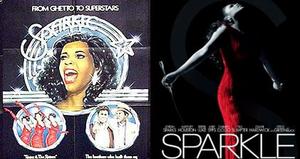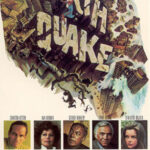Let the record show that the “Sparkle” remake, in and of itself, is one of Hollywood’s better films with a mostly black cast. But those who have devoured the 1976 original time and time again surely notice the drastic deviations from the classic film. Deviations aren’t necessarily a new concept where American remakes are concerned. But in this case, some of the changes may have dampened the story’s impact, softening the charm. Some of the changes seem trivial; others appear to have legitimate roots. Observe.
Time’s-a-Changin’
Let’s start with the obvious-the time period. The original film begins in 1958; the remake starts in 1968. Anyone who has lived through the Civil Rights Era knows what a difference a decade makes. The kind of existence that many black people experienced in 1958 was drastically different from 1968.
Possible reason for the switch: One of the major themes in the original was the oppression that African-Americans felt during the 50s and early 60s. This theme could be more easily glossed over closer to the 70s, with more focus being on the girls’ singing careers.
Sparkle’s new home…
Another obvious change? The setting. Original “Sparkle” fans may recall that the story takes place in Harlem. However, the new-and-improved version is set in Detroit.
Possible reason for the switch: As Detroit is the home of Motown, this tidbit gives filmmakers additional room to make creative changes to the plot.
Names have been changed…
Some of the names have been altered from the original. The 1976 version revealed that the family’s name was Williams. In the new movie, the surname has been changed to Anderson. Mama Effie has become Emma; other modifications exist.
Possible reason for the switch: This one is a bit puzzling. Even though the remake remains a period film, the name alterations seem like one of the movie’s unnecessary changes.
Mama’s Got a Job
In the 2012 remake, Emma’s character owns a clothing boutique instead of working as a maid (in the original.) There is a big difference between being a maid and owning your own clothing boutique.
Possible reason for the switch: In today’s spirit of female empowerment, it makes sense that filmmakers might want to deviate from the “struggle” many blacks endured during the 50s and 60s.
Age Ain’t Nothin’ But a Number…
In the original film, Sparkle is 15 years old; in the newer version she is 19.
Possible reason for the switch: Underaged sexual activity is implied in original; Sparkle and Stix go to a motel to have sex. This would never fly in today’s “politically correct” society. (Side note: It is reported that Aaliyah was once considered for the lead role; but she died before filming could begin.)
Satin Struthers’ Career
Satin Struthers is a “big time” gangster in the classic version. As a result, the viewer is shown many different illegal activities: cockfighting, drug pushing, and excessive violence are all part of the game. In the 2012 version, Satin (played by Mike Epps) is a smarmy comedian with “a bad attitude and violent tendencies.”
Possible reason for the switch: It’s likely that filmmakers wanted to avoid glorifying violence and criminal lifestyles, focusing instead on the girls’ wholesome personalities.
Where are The Hearts?
In the original, the girls first sang in a group called The Hearts-with Stix and Levi. This too was omitted from the 2012 “Sparkle” remake.
Possible reason for the switch: Filmmakers probably wanted to strengthen the ladies’ musical presence, and found this piece of the tale rather superfluous.
A Mother’s Support
If you’ve seen both versions of “Sparkle” you might agree that another major plot twist exists: Effie/Emma’s attitude toward her daughters’ showbiz dreams. In 1976, Effie was very proud of her girls’ singing skills and even visited the nightclub where they performed. Whitney Houston’s “Emma” character is a former singer who blatantly opposes any forms of secular music.
Possible reason for the switch: Focusing on the “evils” of the entertainment world provides a subliminal lesson to viewers. It also provides another dynamic in the film since others have been chipped away from the original. Perhaps this switch is a result of (producer) T.D. Jakes’ religious hand.
Major Plot Twist
Members of the mafia who want control in Sparkle’s aspiring musical career kidnap Stix. But he doesn’t relent-even if it means Max Gerber’s goons kill him. His tenacity impresses the mob guys and they let him go.
Possible reason for the switch: As this part of the storyline was completely removed from the freshened adaptation, it’s probable that filmmakers didn’t want to glorify mafia activity on any level.
More Mama Changes…
In the new version, Mama Emma sings a moving spiritual. This didn’t take place in the original at all. Additionally, Effie smokes a cigarette while watching her girls’ perform at the nightclub.
Possible reason for the switch: Obviously, Whitney’s song was added as a way to showcase her vocal skills. Also, since Houston’s smoking habit was a source of contention during her life, it’s only natural that filmmakers would want to omit this detail.
A sister’s love…
Dolores in the older film, takes matters into her own hands by seducing one of Satin’s thugs in an attempt to frame Satin in a drug sting. The ploy has devastating results in the original film.
Possible reason for the switch: Sexual manipulation is perhaps something that filmmakers wanted to avoid depicting on screen.
Sparkle’s Debut Gown
Sparkle’s “sparkly” red gown with its plunging neckline is pretty hard to miss in the updated version of the film, as opposed to the dress she wears in the 1976 classic, which covers the singer from neck to toe. What’s even more shocking about the 2012 installment is that Emma (who has strict religious beliefs) selects such a revealing garment for her daughter.
Possible reason for the switch: The dichotomy of this situation is a little jarring for those who recall the earlier movie, as the logic just doesn’t match. The only conceivable reason for this change would be to highlight actress Jordin Sparks’ enviable figure.
Sparkle’s Debut Performance
Sparkle takes the stage in the updated movie with a full choir and playing a piano, which seems to contradict the sexy nature of her performance. This did not take place in the original film; she sang with back-up singers called The Ladies instead of a choir.
Possible reason for the switch: It might be assumed that this detail is also a result of Jakes’ religious influence. Even though allowing Jordin Sparks to showcase her musical skills was a decent idea, the contradicting imagery sort of ruins the viewers’ suspension of disbelief.
Sister and Satin switch places…
In the 2012 “Sparkle,” Dolores accidentally kills Satin while defending her sisters from his violence. Sister takes the fall for the murder and ends up in jail. But in the original, it is Sister who dies of a drug overdose (thus prompting Sparkle’s moving church hymn.)
Possible reason for the switch: Again, to avoid focusing on drug use, filmmakers kept the new Sister alive. This altered storyline probably exists so that other deviations in the script would make sense.
Some might argue that the differences between the two films are unremarkable. Indeed, the newer version of “Sparkle” is strong enough to stand on its own, even if it were not a remake. But since it is a remake, it’s only natural to notice the changes. For instance, Satin’s belt-chasing scene (and R. Kelly’s accompanying musical score) seems “cartoonish” compared to the brutality shown in the 1976 “Sparkle.” Nonetheless considering the newer film’s scope, this seems appropriate.
There are several bright spots, including Jordin’s refreshing acting debut—and particularly, Carmen Ejogo’s spirited performance. Advice for those disappointed by the variations? Enjoy 2012 “Sparkle” for what it is: totally digestible, quality Hollywood entertainment.
More From This Contributor:
Casting the Imaginary Remake of 1982’s “Cat People”
Who Should Be Cast in a Remake of “The Wiz?”
Brady Bunch Reboot Planned: Why “Good Times” Could Never Be Remade




